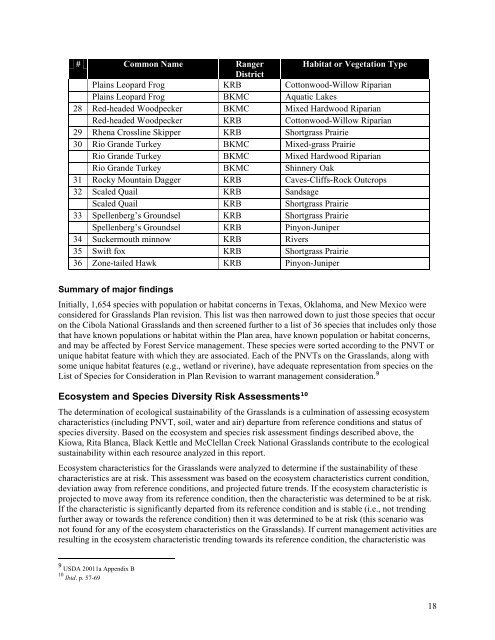Comprehensive Evaluation Report
Comprehensive Evaluation Report
Comprehensive Evaluation Report
Create successful ePaper yourself
Turn your PDF publications into a flip-book with our unique Google optimized e-Paper software.
# Common Name Ranger<br />
District<br />
Habitat or Vegetation Type<br />
Plains Leopard Frog KRB Cottonwood-Willow Riparian<br />
Plains Leopard Frog BKMC Aquatic Lakes<br />
28 Red-headed Woodpecker BKMC Mixed Hardwood Riparian<br />
Red-headed Woodpecker KRB Cottonwood-Willow Riparian<br />
29 Rhena Crossline Skipper KRB Shortgrass Prairie<br />
30 Rio Grande Turkey BKMC Mixed-grass Prairie<br />
Rio Grande Turkey BKMC Mixed Hardwood Riparian<br />
Rio Grande Turkey BKMC Shinnery Oak<br />
31 Rocky Mountain Dagger KRB Caves-Cliffs-Rock Outcrops<br />
32 Scaled Quail KRB Sandsage<br />
Scaled Quail KRB Shortgrass Prairie<br />
33 Spellenberg’s Groundsel KRB Shortgrass Prairie<br />
Spellenberg’s Groundsel KRB Pinyon-Juniper<br />
34 Suckermouth minnow KRB Rivers<br />
35 Swift fox KRB Shortgrass Prairie<br />
36 Zone-tailed Hawk KRB Pinyon-Juniper<br />
Summary of major findings<br />
Initially, 1,654 species with population or habitat concerns in Texas, Oklahoma, and New Mexico were<br />
considered for Grasslands Plan revision. This list was then narrowed down to just those species that occur<br />
on the Cibola National Grasslands and then screened further to a list of 36 species that includes only those<br />
that have known populations or habitat within the Plan area, have known population or habitat concerns,<br />
and may be affected by Forest Service management. These species were sorted according to the PNVT or<br />
unique habitat feature with which they are associated. Each of the PNVTs on the Grasslands, along with<br />
some unique habitat features (e.g., wetland or riverine), have adequate representation from species on the<br />
List of Species for Consideration in Plan Revision to warrant management consideration. 9<br />
Ecosystem and Species Diversity Risk Assessments 10<br />
The determination of ecological sustainability of the Grasslands is a culmination of assessing ecosystem<br />
characteristics (including PNVT, soil, water and air) departure from reference conditions and status of<br />
species diversity. Based on the ecosystem and species risk assessment findings described above, the<br />
Kiowa, Rita Blanca, Black Kettle and McClellan Creek National Grasslands contribute to the ecological<br />
sustainability within each resource analyzed in this report.<br />
Ecosystem characteristics for the Grasslands were analyzed to determine if the sustainability of these<br />
characteristics are at risk. This assessment was based on the ecosystem characteristics current condition,<br />
deviation away from reference conditions, and projected future trends. If the ecosystem characteristic is<br />
projected to move away from its reference condition, then the characteristic was determined to be at risk.<br />
If the characteristic is significantly departed from its reference condition and is stable (i.e., not trending<br />
further away or towards the reference condition) then it was determined to be at risk (this scenario was<br />
not found for any of the ecosystem characteristics on the Grasslands). If current management activities are<br />
resulting in the ecosystem characteristic trending towards its reference condition, the characteristic was<br />
9<br />
USDA 20011a Appendix B<br />
10<br />
Ibid. p. 57-69<br />
18
















